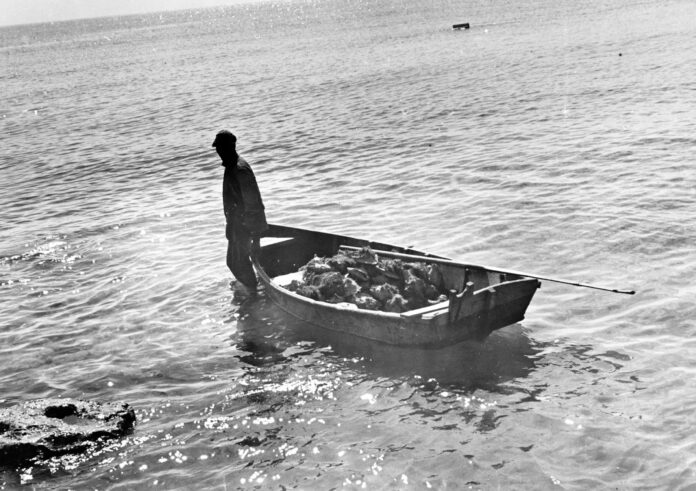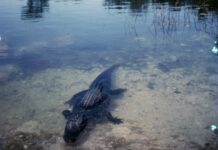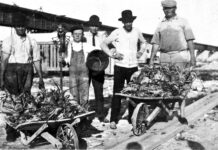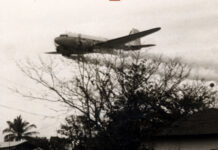
In the old days, fishing skiffs slowly paddled across the clear Atlantic waters with two fishermen on board. One man slowly paddled while the other dipped a glass-bottomed bucket beneath the surface and scanned the bottom for Strombus gigas.
When one was spotted, his partner stopped paddling and grabbed a pole, sometimes 30 feet long. The “hooker” would skillfully maneuver the pole through the water until he was able to insert the hook at the end of the pole into the lip of the shell and bring it back to the surface. The process was repeated until the boat’s planks were covered with horny shells.
Strombus gigas is the elegantly-housed gastropod, or sea snail, more commonly called the queen conch. As this is the Florida Keys, there is a great deal to be said about the conch – specifically, the pink-lipped queen conch. The queen is only one of an entire family of Strombidae, slowly moving on their long foot through the warm shallows that roll up against Florida’s beaches and islands. Other species of true conchs in the waters surrounding Florida and the Keys are the milk conch and fighting conch.
The massive horse conch, the largest gastropod inhabiting the Sunshine State’s coastal waters, and Florida’s state shell, is not from the family Strombidae and, therefore, not a true conch. Neither a conch nor a whelk, the horse conch is the second largest gastropod in the world and a tulip snail from the Fasciolariidae family.
According to the dictionary by Merriam-Webster: “conch (kongk, konch) is 1. the spiral shell of a gastropod, often used as a horn. 2. any of various marine gastropods. 3. the fabled shell trumpet of the Tritons. 4. a native or inhabitant of the Florida Keys.” Elegantly housed and slow-moving, the pinked-lipped shell of the queen conch is a fitting symbol for an island chain referred to as the Conch Republic.
For the record, conch rhymes with bonk and honk, and not haunch or paunch – though that is not what the aboriginal people called it. What they called it, I do not know. I do know they used the meat as a protein and the shell as a tool, weapon and ceremonial object. Inhabitants of the Florida Keys have always dined extensively on conchs. The meat was valued, and the shell has been a must-have souvenir for more than 100 years.
When they are not harvested, or eaten by turtles, octopus or nurse sharks, they can live 20 to 30 years. As fast as snails, however, the queen conch was nearly picked clean from Florida’s waters, and like the sponge and turtle industries before it, the conch fishery boomed and busted. The island chain’s old-timers sometimes talk about wading through the shallows, picking them up, and bringing them home for dinner. In the 1950s, they could take a watery stroll while pulling a small wooden skiff behind them and fill it up in a few hours.
The locals and fishermen had to see what was coming, especially as the 1960s began creeping up in the 1970s. Like many industries before and after it, the harvesting of conch and the industry it supported collapsed, and the culprit was overfishing. The first to go was the commercial side of conch fishing, with the commercial harvesting of conch being banned in 1975. The recreational harvest was banned in 1985, and in 1986, taking live conch was banned in federal waters.
A few years ago, I was at a Florida restaurant and, while perusing the menu, noticed that they offered conch fritters and “local” cracked conch. For the record, local conch has not been served in the Florida Keys or anywhere else in the country for decades. However, I have long since heard rumors of one of the Florida Keys fast food establishments – which will not be identified – that, along with their chicken, served fried conch through their drive-through window. From what I have heard, it was amazing. I hope it was not poached conch.
The conch shell is a symbol of the Florida Keys, and fittingly it is emblazoned on the flag of the Conch Republic. The self-proclaimed micro-nation made international headlines when it was formed in 1982. More of a publicity stunt than anything else, the extraordinary measure was enacted to protest the United States government after it effectively erected a border checkpoint at the top of the road leading into the Florida Keys and constructively ended the tourism trade.
The motto of the newly formed “country” was “We seceded where others failed.” While the political protest was brief, and Conch Republic officials surrendered to the U.S. Navy shortly after declaring the Conch Republic a sovereign nation, the heart and soul of the Conch Republic (as well as the national flag) have remained an integral part of the island chain’s identity ever since.
Strombus gigas, on the other hand, has continued to struggle in its native waters. Though it is still found on menus up and down the Florida Keys, today’s conch is imported from Central America, Jamaica, and the Turks and Caicos – home to the Caicos Conch Farm, the world’s first commercial conch farm.
The Conchs who live on the islands, the families who have lived on these islands for generations, are as proud of their heritage and as strong as ever. The Honorary Conchs, on the other hand, are those residents who have been given the title by the official declaration of the acting mayors of the Florida Keys over the decades, myself among them, and like the horse conch, we will never be considered true Conchs.

























